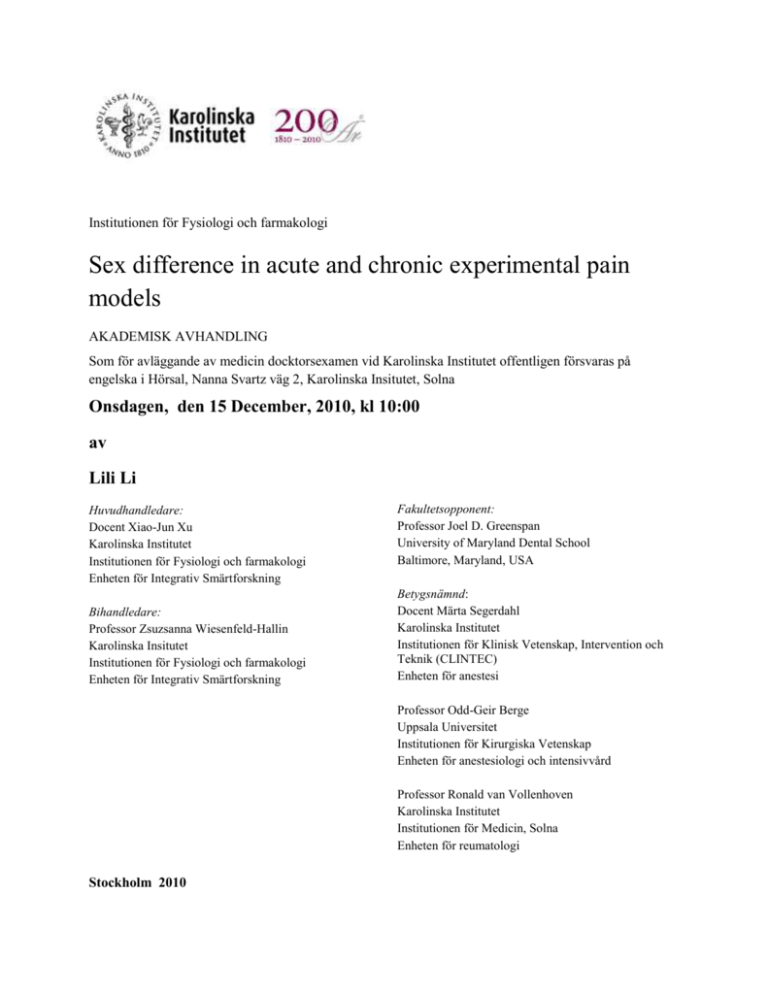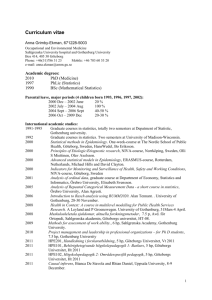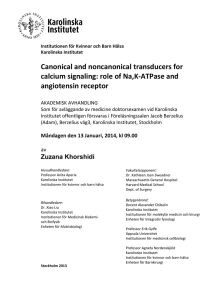Institutionen för Fysiologi och farmakologi Sex difference in acute
advertisement

Institutionen för Fysiologi och farmakologi Sex difference in acute and chronic experimental pain models AKADEMISK AVHANDLING Som för avläggande av medicin docktorsexamen vid Karolinska Institutet offentligen försvaras på engelska i Hörsal, Nanna Svartz väg 2, Karolinska Insitutet, Solna Onsdagen, den 15 December, 2010, kl 10:00 av Lili Li Huvudhandledare: Docent Xiao-Jun Xu Karolinska Institutet Institutionen för Fysiologi och farmakologi Enheten för Integrativ Smärtforskning Bihandledare: Professor Zsuzsanna Wiesenfeld-Hallin Karolinska Insitutet Institutionen för Fysiologi och farmakologi Enheten för Integrativ Smärtforskning Fakultetsopponent: Professor Joel D. Greenspan University of Maryland Dental School Baltimore, Maryland, USA Betygsnämnd: Docent Märta Segerdahl Karolinska Institutet Institutionen för Klinisk Vetenskap, Intervention och Teknik (CLINTEC) Enheten för anestesi Professor Odd-Geir Berge Uppsala Universitet Institutionen för Kirurgiska Vetenskap Enheten för anestesiologi och intensivvård Professor Ronald van Vollenhoven Karolinska Institutet Institutionen för Medicin, Solna Enheten för reumatologi Stockholm 2010 Abstract Sex differences in response to noxious stimuli and in the development of chronic pain have been increasingly recognized and studied in humans and laboratory animals. In the clinic, extensive evidence indicates that there are a large number of chronic pain conditions that have higher prevalence in women than in men and some of these conditions, such as migraine and temporomandibular pain disorder, are also affected by the menstrual cycle. The mechanisms for sex differences in pain, particular in chronic pain, are largely unknown. The work presented in this thesis aims to explore mechanisms of sex differences using experimental pain models in rodents. In the first part of the thesis, we explored the role of estrogen receptors and the adenosine A 2A receptor in sex differences in pain using genetically modified mice. We observed that in wild-type controls for estrogen receptor α or β knock-outs, females were significantly more sensitive than males to mechanical stimulation under normal condition and after carrageenan-induced inflammation. Such sex differences were eliminated in mice lacking either estrogen receptor α or β. Mechanical hypersensitivity resulting from partial sciatic nerve injury did not however differ between the sexes or between the wild-types and both estrogen receptor knock-outs. These results suggest that estrogen receptors α or β play a role in sex difference in basal mechanical pain threshold and inflammatory hypersensitivity. There was no sex difference in baseline mechanosensitivity in mice lacking the adenosine A 2A receptor and wild-type controls. Carrageenan-induced mechanical hypersensitivity was significantly reduced in the A2A receptor knock-outs compared to wild-types. ZM-241,385, a selective A2A receptor antagonist, reduced inflammatory hypersensitivity in wild-type females, but not in males. The selective A2A receptor agonist CGS 21680 produced significantly more hypersensitivity in wild-type female mice than in males. These results suggest that activation of peripheral adenosine A2A receptors contributes to inflammatory hypersensitivity and that this effect is more prominent in females than in males. The second part of the thesis deals with the development of neuropathic pain-like behaviors (allodynia) in rats after spinal cord or infraorbital nerve injury. We observed a significant sex difference (females > males) in the development of mechanical allodynia after spinal cord injury in rats independent of the extent of injury. Increased mechanical hypersensitivity in females was not related to estrous stage at the time of injury. Similarly, after infraorbital nerve injury, female rats developed more persistent local and spread mechanical allodynia which was also not influenced by the estrous stages at the time or after injury. These studies provide further evidence for the presence of sex difference in baseline mechanical pain threshold, inflammatory hypersensitivity and experimental neuropathic pain in rodents. Furthermore, our results showed that estrogen receptors and adenosine A2A receptor may be involved in sex difference in pain sensitivity under normal condition or after inflammation. Finally, although female rats developed more persistent allodynia-like behaviors after spinal cord or infraorbital nerve injury, there appears to be no impact of the estrous cycle on pain development. Key words: estrogen, adenosine, sex difference, nociception, carrageenan, inflammation, neuropathic pain, mice, rats ISBN 978-91-7457-150-9

